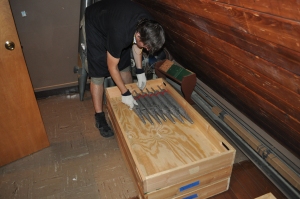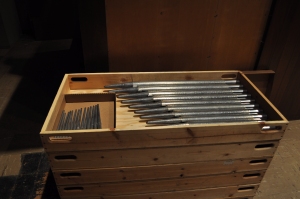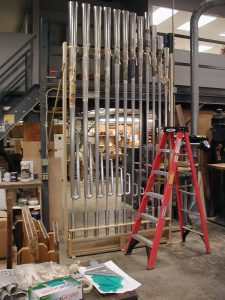Pipe Organs 101
So, just what is a “pipe organ”?
A pipe organ is a musical instrument that produces sound by air vibrations created in an organ pipe, which is controlled by a musician from a keyboard. The pipe organ has been around for quite some time, much longer than the piano.
How is sound made by the pipes?
Sound is air that is vibrating. It’s like when you blow across the top of a soda bottle- it makes a “note”, a sound that has a specific frequency of vibration called pitch. Similarly, one organ pipe produces one tone at one pitch; a given pipe is not mechanically manipulated in some way to produce multiple notes like a flute or guitar string. Since there is just one pipe for each note, a keyboard with 61 notes (5 octaves) would have 61 pipes, one for each note. The one set of pipes for each note on the keyboard makes just one kind of sound. The organ will have several sets of pipes; each of these sets of pipes is called a “rank”, which can make different sounds. This is similar to an orchestra which has many different types of instruments, each having its own characteristic sound. If a keyboard of 61 notes controls a group of 10 ranks of pipes, there will be 610 pipes playable from that keyboard. There are many more pipes in an organ than the ones you typically see. Our organ will have manuals with 58 notes instead of 61, a common configuration.
So why can’t you see all the pipes?
The pipes are arranged on a windchest as shown in the drawing below, and typically only the main Principal stop is visible. This rank is also called a Praestant, which is what we’ll have. The windchest and pipes are enclosed on the sides and back by the back wall that our contractor installed, so that the sound projects out the front more clearly. It’s like when you’re yelling to someone- you hold your hands up by your mouth to help project the sound so they can hear you better. The organ chamber walls act the same way, projecting the sound into the room.
How does an organ make different sounds?
 |
| Cross-Section of an Open Flue Pipe (front and side views) and Reed Pipe |
There are several basic methods an organ builder has at his disposal to make different sounds come from the pipes. These are:
- Choice of two basic pipe types, flue pipes or reed pipes.
- Changes in pitch.
- Changes in shape.
- Use of several pipes combined together as a set.
The tone of a musical note can be very complex, but basically consists of the main or fundamental pitch, and harmonics of that fundamental pitch. The number and strength of the harmonics are what defines a tone- it’s like the human voice: people have unique sounds to their voice that differ slightly because the harmonic content of each person’s voice differs. If a friend walks up behind you and says “hi there”, you can often guess who it is just by the sound. You can probably identify several hundred people when hearing just a few words from them or your name because of the unique harmonic content of each voice.
What exactly are harmonics?
When you play a middle C note on a piano, the middle C string inside the piano vibrates to make the middle C note sound. However, while the string is producing this middle C note, the string can also simultaneously vibrate in such a way as to make the note an octave above middle C. An organ pipe has this same characteristic as a vibrating string, except it is a vibrating column of air. It not only makes the sound of the middle C note, but an entire series: the C one octave above, the G one and one-half octaves above (12 notes up), the C two octaves above, the E 17 notes up, and so on. Of course these harmonics are not at the same loudness and the volume relative to the main note is what creates the characteristic tone.
There’s underlying mathematical logic behind these harmonics. If a note is producing a certain pitch, the harmonics are simply that pitch multiplied by whole numbers, so the harmonics are a 2x, 3x, 4x, 5x, 6, and so on. Twice the pitch is the octave, 3x is the G that is 12 notes up, 4x is two octaves, 5x is the E 17 notes up, and so on. These principles of sound are true of the human voice and all musical instruments, not just organ pipes.
How does the keyboard control the pipes?
The pipes are made to sound when air under a low pressure is blown into the bottom or foot of the pipe. The foot of each pipe sets on a hole on the top of a box-like structure. The box has a separate channel for each note. There is a chamber of low pressure air supplied by a small blower, and a set of valves which control the flow of air into the individual note channels. The proper pipe from each rank sits above the channel for that note, so for example the low C pipe sits above the low C channel which is controlled by the low C on the keyboard. Organ builders call the air supply wind and the chamber the wind chest. In our example, there would be 61 valves leading to 61 separate channels, one for each note. Each valve is opened and closed by playing the corresponding key on the keyboard. The valve is actuated in our organ by an electromagnet controlled by the key.
|
| Click here to view photo of an actual organ illustrating the pipes on the windchest like this drawing. |
What is a “stop”?
In the very early days of organ building, all the ranks of pipes were played together and there was no way to separate which types of ranks were used. It’s sort of like a big choir where everyone sings together and there weren’t any solo voices. Over time, there was a mechanism invented called a slider that was used to stop or isolate a ranks of pipes. The slider was a thin piece of material with holes in it that would run cross-wise to the channels and be underneath the pipes. At the organ console, a lever would move this slider between two positions- one where the holes would line up and allow all the pipes in a rank to receive air from the channels and another where the holes would not line up and thus block the air flow. Because the historical precedence was to have all the ranks on, the slider was viewed as stopping the sounding of pipes. (Besides, having a “start” just doesn’t sound right!)
So what are the main sounds an organ can make?
The main sound of an organ is called a “principal” tone. These pipes are straight and are usually the ones that are visible when you look at the organ. Often they are made of highly polished tin, which produces a bright sound and looks nice. The sound is probably most like a modern orchestral flute, which also produces a bright sound, has a long, straight tube, and has a small “attack” sound when the sound is first produced. The initiation of the sound, called chiff can be made somewhat stronger or weaker depending on how the organist plays the keys, and provides articulation to the notes.
The main principal sound is at a range that is called eight-foot (8′) pitch. This is because the lowest C on the keyboard has a pipe with a resonating length of 8′, and is the same pitch as you have on a piano. If we have a set of 61 pipes, with the low C being 8′ long, we can add a second set where the pipes are one-half the length of the 8′ stop, so the low C is only 4′ long. This second set we will call a 4′ Principal or 4′ Octave. Each note has its main pitch one octave above the 8′ pitch note.
What other ways to change the sound are there?
As we described before, adding sets of pipes at successively higher harmonics can change the sound. As we alluded to earlier that the shape of a pipe can also change its sound. In the organ there are two main categories of pipes: flue pipes and reed pipes. Flue pipes have no moving parts and generate their sound by vibrating air in a column like a flute or recorder. Reed pipes have an actual mechanical reed, like a clarinet, at the base and then have a resonator above.
Flue pipes can be further classified into two sub-categories: open pipes and stopped or closed pipes. Open pipes are open at each end and have a full harmonic series with the main pitch and harmonics at a frequency of 2x, 3x, 4x, 5x, etc. Stopped pipes have a cap on the top and thus the pitch is one octave lower than the pipe would be if it was open. These pipes have only the odd harmonics: 1x, 3x, 5x, 7x, etc. Pipes having only odd harmonics have a uniquely different sound than open pipes.
As a general rule of thumb, the narrower the pipe, the more harmonics it will have, and the wider the pipe, the fewer harmonics it will have. Straight pipes also have more harmonics than tapered pipes. So an organ builder has plenty of things to change to make different sounds: tube shape (straight, tapered), whether is it stopped or not, and pipe material composition.
Pipes are typically made from a tin-lead metal, with the tin content being 30%, 50%, or 70%, and sometimes 90% for the visible pipes. Tin is more expensive than lead (yes, plain old economics is a factor!) and also produces a brighter sound. Pipe metal made at the 50/50 tin/lead mixture is sometimes referred to as “spotted metal” because of an unusual metallurgical property where the metal surface has round patterns approximately 3/8″ in diameter. Pipes also can be made of wood. Wooden pipes are typically square or slightly rectangular in cross-section, and are most often stopped pipes.
We had said earlier there are harmonics at successive octaves, but also in-between the octaves. For example, the third harmonic from the low C is a G, up 12 notes from the C The fifth harmonic is close to the E, 17 notes up from the low C. There are stops where the primary pitch of the pipe is made to be at these non-octave harmonics, so when you play a C, the pipes plays a G or E! These stops are called mutations and their designated length a fraction instead of the usual 8′, 4′, 2′ etc. A common mutation would be a 2 2/3′ (the G, or 12th) and a 1 3/5′ (the E, or 17th) stop. This may sound strange on paper, but when you hear it, it blends perfectly and sounds like another sound “color”.
Another stop type is called a mixture. These stops have several pipes that sound together and are not separable. (They may also be called “compound” stops.) These pipes are typically principal-types and sound above the 2′ Octave at the G, the next C, the next G, then the next C. These pipes reinforce the main harmonics and have a sound that is unique to the organ.
Why do organs have several keyboards and pedals?
So far we’ve explained everything pertaining to just one keyboard. Just as a human body is made of several organs like the heart and lungs that serve different purposes, an organ is in reality a collection of several organs which serve different musical functions.
The second keyboard will control a second windchest with its own pipes. Traditionally, this second keyboard would control a positive organ which would be lighter in character and an octave higher in pitch. The main principal stop would be a 4′ pitch and its first octave would be at 2′ pitch. Our new instrument will have 3 manuals and pedal.
The pedal organ is played with the feet and is typically designed at an octave lower than the main organ, so its would likely have a 16′ Principal as its main stop. Pedal boards typically have 32 keys ranging from low C to G two and one-half octaves higher. Ours will have 30 notes, again, a common configuration.






